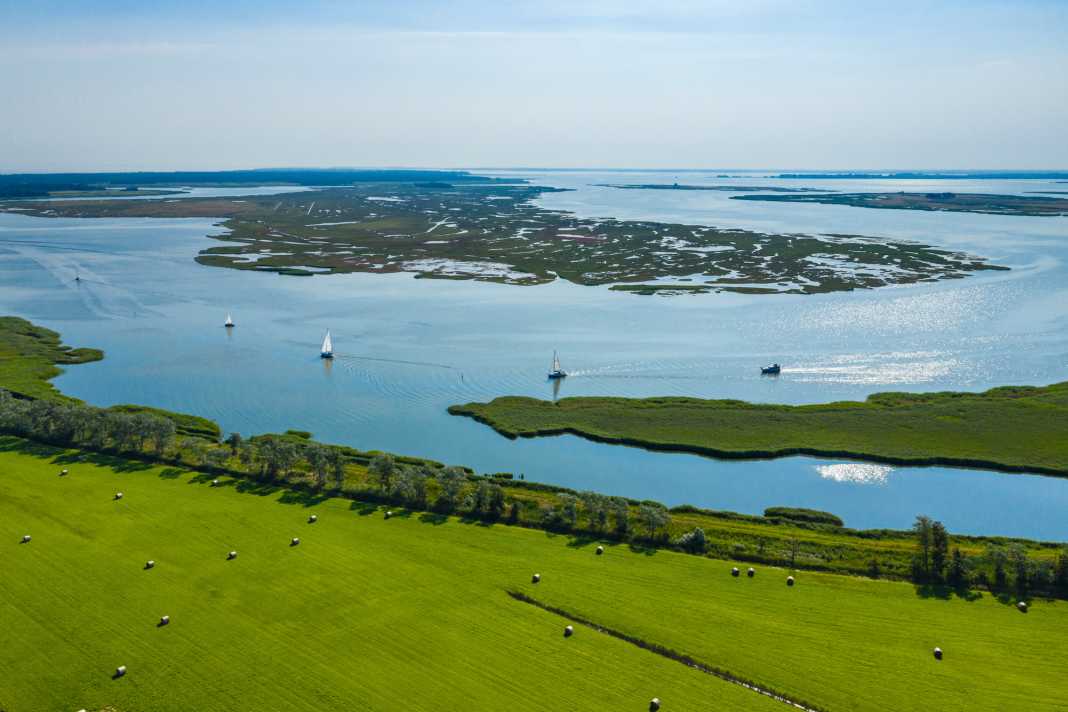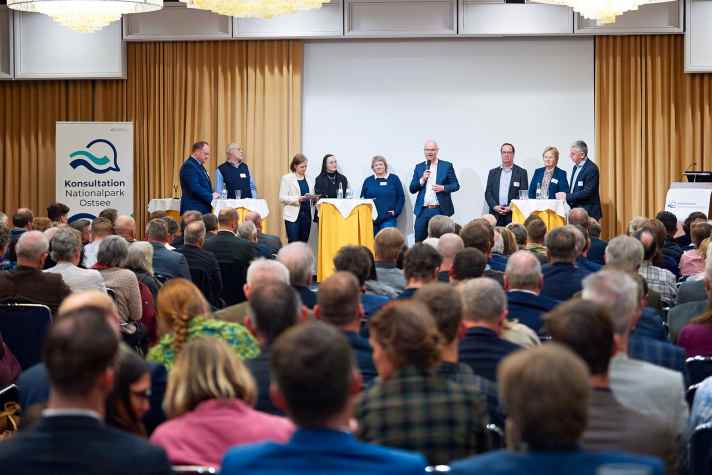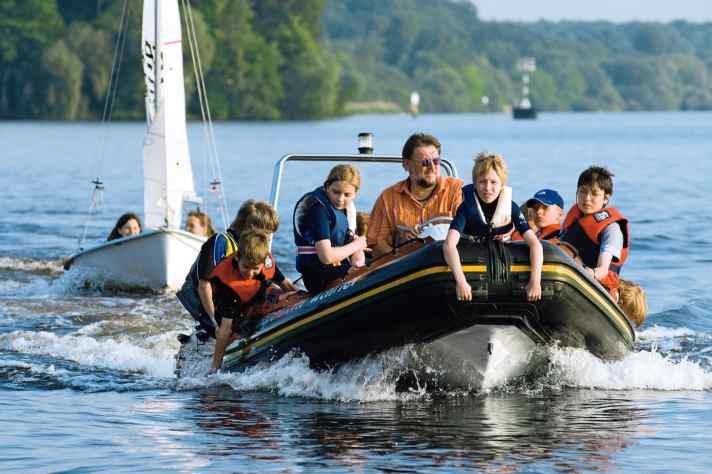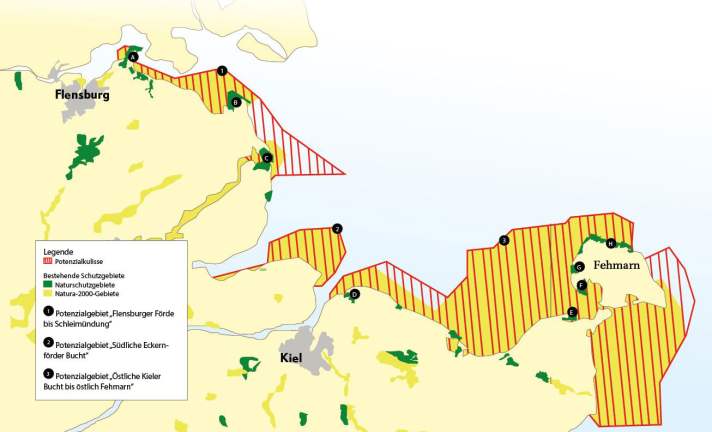Potential backdrop: The plans for a Baltic Sea National Park





Around 300 stakeholders accepted the invitation of Schleswig-Holstein's Environment Minister Tobias Goldschmidt to Kiel on 21 March to find out about the plans for a Baltic Sea National Park. It was the starting signal for one of the central environmental policy projects of this legislative period, said the Green Minister, who emphasised that it was also very important to him personally. After all, the Baltic Sea is in a bad way, it is a sick sea, and a turnaround is needed to change this.
During negotiations with the CDU in the summer of 2022, Goldschmidt had already succeeded in having his concerns included in the coalition agreement of the newly formed state government. According to the agreement, the aim is to improve marine conservation in Schleswig-Holstein's Baltic Sea. The aim is to strengthen the protection of species and habitats based on the existing protected areas:
National park to offer benefits for tourism and the economy
"There could be many benefits for marine nature conservation, tourism, the regional economy and local residents from a Schleswig-Holstein Marine National Park in the Baltic Sea, which could build on existing protected areas and significantly strengthen their effectiveness."
Such a national park will be discussed in an intensive consultation process with the relevant social interest groups and a decision will be made in the coalition towards the middle of the legislative period as to whether and in what form it will be launched.
This evening event marked the beginning of this exchange, in which information was provided about the project, but in which representatives from science and environmental protection on the one hand and from water sports, tourism and fishing on the other also had their say with a great deal of verve and sometimes harsh criticism.

Almost the entire Baltic coast of Schleswig-Holstein is to become a national park
The basis for the discussions was a programme developed so-called potential backdrop in which existing nature conservation and Natura 2000 areas are depicted and linked together. The result is an area that must frighten boaters with regard to possible restrictions on use, because with a few exceptions, almost the entire water area on the Schleswig-Holstein Baltic Sea coast is affected: the area along the coast from Flensburg to the Schlei with an area of 26,381 hectares, the water area from Eckernförde to Strander Bucht including the Stollergrund with an area of 12,139 hectares and the coastal waters of eastern Holstein including Fehmarn with an area of 4,500 hectares.
This means that an area the size of Hamburg is being discussed. The Baltic Sea National Park would be the 17th and, at 161,000 hectares, the second largest in Germany - after the Schleswig-Holstein Wadden Sea National Park with 441,500 hectares.
When asked, Minister Goldschmidt left open the question of whether all three areas would actually be combined to form a national park or whether such a park would only be established in one of the three areas mentioned, as well as the answer as to what else would be possible in the national park. Both are still to be discussed in the consultation process: "I cannot enter into an open-ended dialogue and make statements about individual restrictions on use beforehand," said Goldschmidt. However, as Environment Minister, he is interested in protecting as much land as possible.
Parts of the national park are to be left to their own devices
It is already clear what the planned national park must at least fulfil according to the requirements of the legislator, as this can be seen from Section 24 of the Federal Nature Conservation Act. This requires a large-scale and largely undissected area of special character, the majority of which fulfils the requirements of a nature reserve and is in a state not influenced by humans or can be developed into such a state.
This is a point that must worry boaters, because in individual cases it can mean that a region is left to its own devices to the exclusion of humans. This is also how the legislator sees it. It states in Section 24: "The aim of national parks is to ensure that the natural dynamics of natural processes are as undisturbed as possible in a large part of their area." According to the law, national parks may only serve the public's experience of nature to the extent permitted by this protective purpose.
The Baltic Sea is sick. We need a turnaround. That's why I think it's right for us to raise the issue"- Tobias Goldschmidt, Minister of the Environment, Schleswig-Holstein
What the majority of the national park area means in officialese is the so-called core zone of at least half of the national park area, in which the most severe restrictions apply. It remains to be seen which areas will ultimately belong to the core zone and what will still be permitted there, whether boaters will still be allowed to use the coastal waters of Schleswig-Holstein as before. It is already clear that angling or even fishing will be prohibited here. According to Minister Goldschmidt, nothing may be taken from or added to the core zone.
Core zone, development zone and maintenance zone- The national park should grow
The core zone is to be followed by a development zone, which is to be developed into a core zone over a period of 30 years. The buffer to the outside world is then formed by a maintenance zone, which may be used explicitly for recreation and can also be managed with restrictions, for example through sustainable fishing.
At the launch event, the supporters of the project emphasised several times that water sports were seen as a cultural heritage of the country and an important economic factor. Sailing was mentioned as a good example of a nature experience that is possible in harmony with the conservation purpose of a national park. However, it will certainly be part of the upcoming discussions whether this will also include a night at anchor or Opti training using a motorised safety boat.

Workshops for dialogue with stakeholders
In order to clarify all of these questions, the ministry has organised six workshops over the coming year in which it intends to exchange views with stakeholders from the fields of nature conservation, fishing, water sports, tourism, the regional economy and local authorities in order to sound out acceptance and determine whether the desired water protection can be achieved at all through the project. Only then, according to Environment Minister Goldschmidt, should a political decision be made as to whether a Nature Park Act should be introduced.
At the opening event in the large hall of a Kiel hotel with a view of the fjord, different voices were raised in this regard. Environmental scientist Prof Dr Karen Helen Wiltshire from the Alfred Wegener Institute shook her head with her statement that nothing less than the future of humanity was at stake. Lorenz Marckwardt, Chairman of the Schleswig-Holstein State Fisheries Association, on the other hand, received the first long applause of the evening. Pointing out that the proposed area already consisted of protected areas, the fishing champion asked whether the state of the Baltic Sea could not be helped more effectively by the ministry doing something about the inputs from agriculture and munitions waste.
The Baltic Sea is not only a habitat for animals and plants, but also for humans"- Timo Gaarz, District Administrator of Ostholstein
Manfred Wohnrade from the Schleswig-Holstein Tourism Association expressed great concern on behalf of his members. When asked whether he hoped that a national park would have a magnetic effect, he said: "I don't believe that it would bring even one more tourist to Schleswig-Holstein!"
Will boating remain permitted in the core zones?
The topic of boating was only indirectly represented on this evening. Dr Thomas Liebsch-Dörschner, Vice President of the State Sports Association, called for a fact-based discussion on behalf of all water sports enthusiasts. To this end, it was first necessary to clarify what the previous measures in the existing protected areas had achieved. Only then would it be possible to assess whether further requirements would help at all.

In his closing remarks, Minister Tobias Goldschmidt once again emphasised the importance of sailing. "Sailing is part of our country's culture. Even in the core zones, I don't see why it needs to be banned!"
Nevertheless, the sailing enthusiasts in the audience went home with mixed feelings. The question remains as to how far this is intended. Whether children and young people are also meant whose training, accompanied by motorised safety boats, takes place on the shore. Or cruising sailors who are dependent on the use of the engine. Or anchormen. Will this experience of nature - one of the purposes of national parks according to the law - continue to be possible everywhere it is today?
Recreational boating in the land between the seas has already been subject to severe restrictions. In the Schleswig-Holstein Wadden Sea National Park, restrictions have been in place since 1985, including strict navigation bans. Far worse than the rules themselves, however, is the fact that they have been under negotiation ever since. Demands from the national park administration and conservationists for restrictions on recreational boaters have been a permanent feature since the establishment of the national park, and it takes a great deal of voluntary commitment to at least maintain this unfortunate state of limbo as the least of all evils.
We can only hope that things will turn out differently on the Baltic Sea.
The basis for discussion for the Baltic Sea National Park

The first glance at the map showing the so-called potential area of the planned national park makes every Baltic Sea boater's blood run cold. The question arises as to whether large-scale prohibition zones for skippers will be created on the Schleswig-Holstein coast.
The good news first: the outlined areas are only a proposal so far, and there is still plenty of time for discussions between the Ministry of the Environment and the various stakeholders before a decision is made next year. But what do the individual areas already mean for recreational boaters, and what is the idea behind the Environment Minister's ambitious plans?
The potential areas of the Baltic Sea National Park are based on existing conservation zones of varying degrees. A distinction is made between the Natura 2000 areas shown in yellow and the nature conservation areas marked in green.
Natura 2000 is an EU-wide network of protected areas for the conservation of endangered or typical habitats and species, which includes not only areas on land but also marine areas. In Germany, the federal states are responsible for implementing Natura 2000 on land and in territorial waters (within the 12 nautical mile zone). However, the federal government is responsible for Natura 2000 in the Exclusive Economic Zone (EEZ), which adjoins the 12 nautical mile zone.
Natura 2000 does not yet mean any restrictions for water sports
All Natura 2000 sites in the EEZs of the German North Sea and Baltic Sea cover around 30 per cent of their area. Of the total marine area of the federal and state governments, around 45 per cent is protected as Natura 2000 sites.
The main aim of the protective measures in these areas is to ensure that their condition does not deteriorate, which is to be achieved, for example, by prohibiting the use of these areas, e.g. by prohibiting the dumping of dredged material. However, the ban on releasing alien animals and plants is also one of the typical protective measures, as are restrictions on recreational fishing or conditions such as special permits required for construction measures.
The Natura 2000 areas are not shown on the nautical charts, probably because they have not been affected by recreational boating to date. The much smaller nature reserves have the highest protection status for an area alongside the national park category, in which, among other things, the plant and animal species and their habitats that occur there are to be permanently protected. These are also marked on the nautical charts with navigation bans.
The aim here is to protect resting and breeding birds from disturbance by watercraft. However, commercial fishing is not affected by the prohibited zones.
Some areas of the Baltic Sea are already protected
The existing nature conservation areas of the Baltic Sea essentially include

- A: The ice-age Holnis peninsula in the Flensburg Fjord, which is a refuge for a wide variety of bird species in all seasons.
- B: The Geltinger Birk in the estuary of the Flensburg Fjord, where migratory birds, sea eagles and wild horses can be observed.
- CThe Schleimündung nature reserve, a varied beach forest landscape that serves to protect birds and is grazed by Galloway cattle.
- D: The Bottsand spit north of Wendtorf Marina, which provides shelter for migratory birds as well as natterjack toads and lizards.
- E: The Graswarder nature reserveEin the direct neighbourhood of the cruising Mecca of Heiligenhafen, which includes an eastward-moving spit, as well as the immediately adjacent mudflats and water areas.
- F, G and H:And finally, Krummsteert-Sulsdorfer Wiek , Wallnau and the Northern Lake District three protected areas on Fehmarn, which consist of different ecosystems.
All of these areas make a valuable contribution to the protection of flora and fauna without confronting skippers with large-scale anchoring or even navigation bans. The exclusion zones designated there are small, narrow shallow water areas that cannot be navigated by most keelboats anyway and whose closure meets with broad acceptance among water sports enthusiasts.
At the suggestion of the Schleswig-Holstein Environment Minister, the Natura 2000 areas, with the exception of the Schlei and the Flensburg inner fjord, are to be merged with the nature conservation areas for a national park and in some cases extended to include newly mapped reefs at greater depths.
The three unconnected areas of Flensburg Fjord to the Schleim estuary, southern Eckernförde Bay and eastern Kiel Bay to the east of Fehmarn are therefore under discussion. In particular, seagrass beds, mussel beds, reefs, harbour porpoises and water birds are to be better protected.

